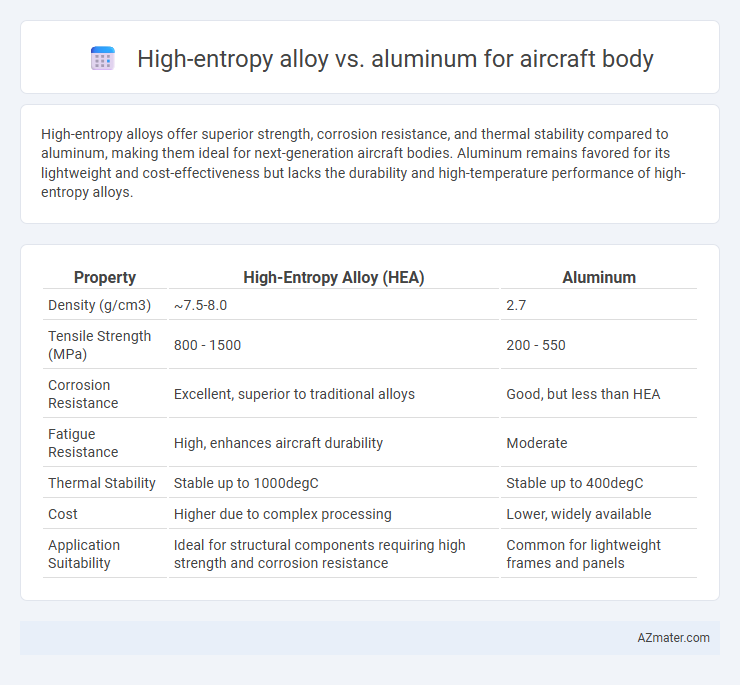High-entropy alloys offer superior strength, corrosion resistance, and thermal stability compared to aluminum, making them ideal for next-generation aircraft bodies. Aluminum remains favored for its lightweight and cost-effectiveness but lacks the durability and high-temperature performance of high-entropy alloys.
Table of Comparison
| Property | High-Entropy Alloy (HEA) | Aluminum |
|---|---|---|
| Density (g/cm3) | ~7.5-8.0 | 2.7 |
| Tensile Strength (MPa) | 800 - 1500 | 200 - 550 |
| Corrosion Resistance | Excellent, superior to traditional alloys | Good, but less than HEA |
| Fatigue Resistance | High, enhances aircraft durability | Moderate |
| Thermal Stability | Stable up to 1000degC | Stable up to 400degC |
| Cost | Higher due to complex processing | Lower, widely available |
| Application Suitability | Ideal for structural components requiring high strength and corrosion resistance | Common for lightweight frames and panels |
Introduction to Aircraft Body Materials
High-entropy alloys (HEAs) offer superior mechanical properties, such as enhanced strength and corrosion resistance, compared to traditional aluminum alloys used in aircraft bodies. Aluminum remains popular due to its lightweight nature, excellent machinability, and cost-effectiveness, making it suitable for structural components. Advances in HEA development aim to reduce aircraft weight while improving durability and fatigue resistance, presenting a promising alternative for next-generation aerospace materials.
Overview of High-Entropy Alloys (HEAs)
High-entropy alloys (HEAs) are advanced materials composed of five or more principal elements in near-equiatomic proportions, offering exceptional mechanical properties such as high strength, corrosion resistance, and thermal stability. Compared to traditional aluminum alloys commonly used in aircraft bodies, HEAs demonstrate superior fatigue resistance and oxidation resistance at elevated temperatures, making them promising candidates for aerospace applications. Their complex microstructures contribute to enhanced performance under extreme conditions, potentially improving aircraft durability and safety.
Aluminum: The Traditional Choice
Aluminum remains the traditional choice for aircraft bodies due to its exceptional strength-to-weight ratio and proven reliability in aerospace applications. Its excellent corrosion resistance and ease of fabrication contribute to reduced maintenance costs and extended aircraft lifespan. Compared to emerging high-entropy alloys, aluminum's well-established supply chain and extensive performance data make it a cost-effective and trusted material for large-scale aviation manufacturing.
Mechanical Properties Comparison
High-entropy alloys (HEAs) exhibit superior mechanical properties compared to aluminum alloys, including higher strength, enhanced wear resistance, and improved fatigue performance, making them highly suitable for aircraft body applications. The multi-element composition of HEAs results in exceptional hardness and thermal stability, surpassing traditional aluminum alloys that typically suffer from lower tensile strength and susceptibility to deformation under high stress. HEAs also demonstrate better corrosion resistance and damage tolerance, contributing to increased durability and safety in aerospace structures.
Weight and Density Analysis
High-entropy alloys (HEAs) exhibit superior strength-to-weight ratios compared to traditional aluminum alloys, making them promising candidates for aircraft bodies where weight reduction is crucial. While aluminum typically has a density around 2.7 g/cm3, many HEAs have densities ranging from 5 to 8 g/cm3, which can increase structural weight if not optimized through alloy design. Ongoing research aims to balance the enhanced mechanical properties of HEAs with their higher densities to achieve lightweight, durable aircraft components.
Corrosion Resistance and Durability
High-entropy alloys (HEAs) exhibit superior corrosion resistance compared to aluminum due to their complex, multi-element compositions that form stable oxide layers, enhancing resistance to oxidative degradation in harsh aerospace environments. HEAs demonstrate exceptional durability, maintaining structural integrity under cyclic loading and high stress without significant fatigue, whereas aluminum alloys are prone to corrosion-related fatigue and localized pitting over time. These properties make HEAs a promising alternative to aluminum for aircraft bodies where long-term durability and corrosion resistance are critical.
Fabrication and Manufacturing Challenges
High-entropy alloys (HEAs) present significant fabrication challenges due to their complex multi-component compositions, requiring advanced casting and powder metallurgy techniques to achieve homogeneity and prevent segregation. In contrast, aluminum alloys benefit from well-established manufacturing processes such as extrusion, rolling, and machining, allowing for easier scalability and cost-effective production in aircraft body structures. The high melting point and limited ductility of HEAs complicate machining and welding operations, while aluminum's favorable thermal properties facilitate conventional fabrication methods and repairability in aerospace applications.
Cost and Economic Considerations
High-entropy alloys (HEAs) offer superior mechanical properties and corrosion resistance compared to traditional aluminum alloys but come with significantly higher production costs due to complex manufacturing processes and expensive raw materials. Aluminum remains the preferred choice for aircraft bodies because of its cost-effectiveness, widespread availability, and well-established recycling infrastructure, which contribute to lower life-cycle expenses. Evaluating economic considerations, the adoption of HEAs in aerospace is limited by initial investment and material costs despite potential long-term performance benefits.
Environmental Impact and Sustainability
High-entropy alloys (HEAs) offer enhanced durability and corrosion resistance compared to aluminum, leading to longer aircraft service life and reduced material waste. Aluminum production is energy-intensive with significant greenhouse gas emissions, while HEAs, despite complex manufacturing, have potential for recycling due to their multi-element composition. Transitioning to HEAs in aircraft bodies supports sustainability goals by minimizing environmental impact through improved lifespan and better resource efficiency.
Future Prospects in Aerospace Engineering
High-entropy alloys (HEAs) offer superior strength-to-weight ratios, corrosion resistance, and thermal stability compared to traditional aluminum alloys, making them promising candidates for next-generation aircraft bodies. Their unique multi-element compositions enable enhanced fatigue resistance and damage tolerance under extreme aerospace environments, potentially extending aircraft service life and reducing maintenance costs. Ongoing research in HEA fabrication and scalability aims to overcome challenges in cost and manufacturing, positioning these materials as vital for future aerospace engineering innovations.

Infographic: High-entropy alloy vs Aluminum for Aircraft Body
 azmater.com
azmater.com